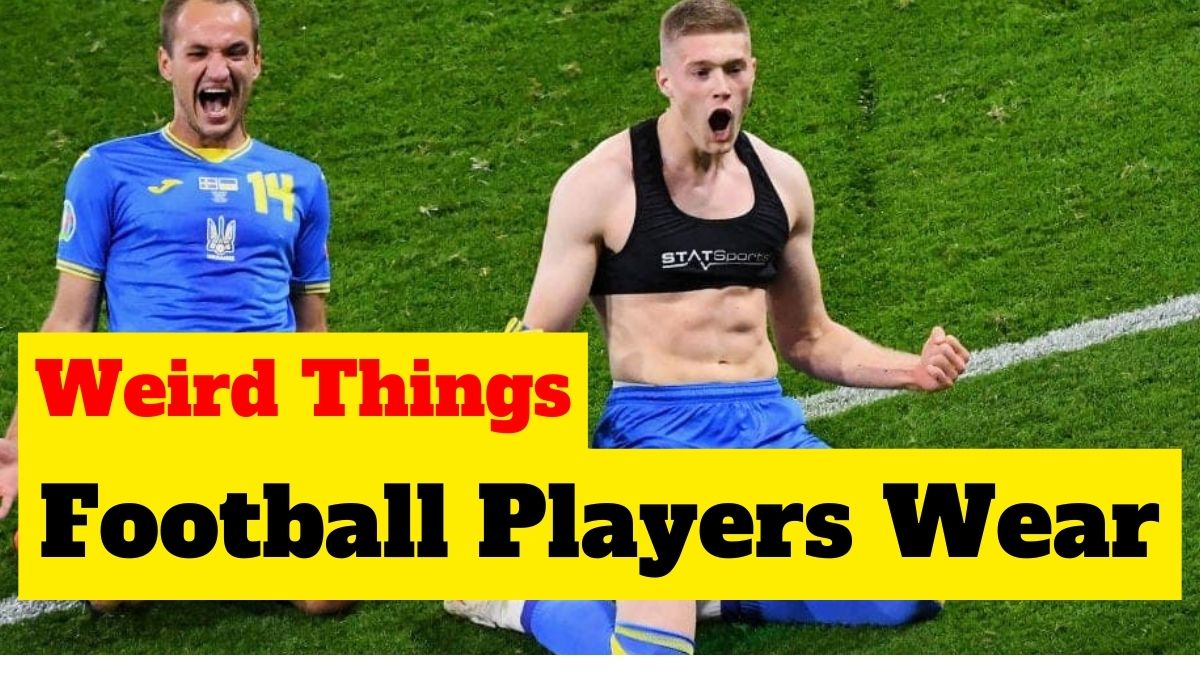Football players wear various pieces of equipment to protect themselves and enhance their performance on the field. Some of these items may seem unusual to those not familiar with the sport, but each serves a specific purpose.
Here’s a list of some of the gear football players wear, along with explanations of their uses:
1. Shin Guards
Soccer players wear shin guards to protect their lower legs from impact during tackles, collisions, and stray kicks from opponents.
These guards are typically made of lightweight but durable materials, such as plastic or fiberglass, and are worn underneath the player’s socks.
Shin guards help prevent injuries such as bruises, cuts, and fractures by cushioning and shielding the shins from forceful contact with other players or the ball.
2. Soccer Socks
Soccer socks serve a dual purpose for players on the field.
Firstly, they hold the shin guards securely in place, ensuring they remain properly positioned throughout the match or training session.
Additionally, soccer socks provide an extra layer of protection to the lower legs, helping to minimize abrasions and irritations caused by friction with the shin guards or the playing surface.
3. Cleats
Cleats are an essential piece of equipment for soccer players, providing traction and grip on the grass or turf field.
The studs or spikes on the sole of the cleats dig into the ground, allowing players to make sharp turns, cuts, and accelerations without slipping.
This traction is crucial for maintaining balance and control, especially during fast-paced movements and changes in direction common in soccer.
4. Goalkeeper Gloves
Goalkeeper gloves are specialized gloves worn by goalkeepers to improve their grip on the ball and protect their hands during saves.
These gloves are designed with padded palms to cushion the impact of catching and punching the ball, reducing the risk of hand injuries.
Goalkeeper gloves also feature latex or silicone surfaces that enhance grip, allowing goalkeepers to securely hold onto the ball even in wet or slippery conditions.
5. Compression Gear
Compression gear, such as compression shorts, shirts, or tights, is worn by soccer players to provide support to their muscles and improve circulation during matches and training sessions.
The tight-fitting garments help reduce muscle oscillation and fatigue, allowing players to perform at their best for longer periods.
Additionally, compression gear can aid in muscle recovery by promoting blood flow and reducing swelling and soreness after intense physical exertion.
6. Ankle Guards
Ankle guards are protective sleeves worn by soccer players to provide support and stability to their ankles.
These guards help reduce the risk of ankle sprains and other injuries by reinforcing the ankle joint and preventing excessive lateral movement.
Ankle guards are especially beneficial for players with a history of ankle injuries or those who play on uneven or slippery surfaces where the risk of twisting or rolling the ankle is higher.
7. Sweatbands
Sweatbands are accessories worn by soccer players to absorb sweat and prevent it from dripping into their eyes during matches and training sessions.
These bands are typically made of absorbent materials, such as terrycloth or moisture-wicking fabric, and are worn on the wrists or forehead.
By keeping sweat at bay, sweatbands help improve visibility and comfort, allowing players to maintain focus and concentration on the game.
8. Snood
In colder climates, soccer players may wear a snood, a type of neck warmer that covers the neck and lower face, during matches or training sessions.
Snoods help keep players warm and comfortable in chilly conditions, reducing the risk of hypothermia and muscle stiffness.
Additionally, snoods can protect the skin from windburn and frostbite, allowing players to perform at their best even in adverse weather conditions.
9. Arm Sleeves
Arm sleeves are worn by soccer players for various reasons, including providing warmth, compression, and protection to the arms during matches and training sessions.
These sleeves are typically made of breathable and stretchable materials that conform to the shape of the arm without restricting movement.
Arm sleeves help regulate body temperature, reduce muscle fatigue, and protect the skin from turf burns and abrasions, enhancing comfort and performance on the field.
10. Headbands
Soccer players wear headbands to keep their hair out of their faces and absorb sweat during matches and training sessions.
These bands are typically made of elastic or moisture-wicking fabric and are worn around the forehead or hairline.
Headbands help improve visibility and comfort by preventing hair from obstructing vision and absorbing sweat that could otherwise drip into the eyes, allowing players to stay focused and alert throughout the game.
11. Bra (Athletic Vest for GPS Trackers)
Male soccer players may wear what appears to be a sports bra, but it’s actually an athletic vest designed to hold GPS trackers or other tracking devices.
These devices are used by coaches and sports scientists to monitor players’ performance metrics such as distance covered, speed, acceleration, and heart rate during training sessions and matches.
The vest securely holds the tracking device close to the body, ensuring accurate data collection while minimizing interference with players’ movements.
This data is valuable for assessing players’ fitness levels, optimizing training programs, and preventing injuries by managing workload and monitoring recovery.
While it may resemble a sports bra, the athletic vest serves a functional purpose in performance analysis and sports science rather than providing support or protection.
12. Mask (Protective)
Some soccer players, particularly those recovering from facial injuries or surgeries, may wear protective masks during matches or training sessions.
These masks are typically made of lightweight materials such as polycarbonate or fiberglass and are designed to shield the face from impact while allowing for clear vision and airflow.
Protective masks help minimize the risk of further injury to the face, nose, or eyes, allowing players to participate safely in the sport.
They are custom-fitted to the individual’s face for optimal comfort and protection, enabling players to return to play sooner after injury.
